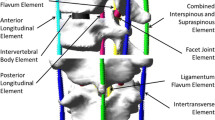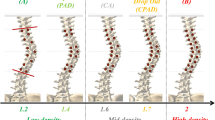Abstract
Purpose
To assess biomechanical differences between AIS instrumentations using concave vs. convex rod first.
Methods
Instrumentations of ten AIS patients were simulated first with major correction maneuvers using the concave rod then with convex rod. Correction maneuvers were concave/convex rod translation, followed by apical vertebral derotation and then convex/concave rod translation. The concave/convex rods were 5.5/5.5 and 6.0/5.5 mm diameter Co–Cr and contoured to 35°/15°, 55°/15°, 75°/15° and 85°/15°, respectively.
Results
Differences in simulated thoracic Cobb angle (MT), thoracic kyphosis (TK) and apical vertebral rotation (AVR) were less than 5° between the two techniques; mean bone-screw force difference was less then 15N (p > 0.1). Increasing differential contouring angle from 35°/15° to 85°/15°, the MT changed from 14 ± 7° to 15 ± 8°, AVR from 12 ± 4° to 6 ± 5°, TK from 23 ± 4° to 42 ± 4°, and bone-screw forces from 159 ± 88N to 329 ± 170N (P < 0.05). Increasing the concave rod diameter from 5.5 to 6 mm, the mean MT correction improvement for both techniques was less than 2°, the AVR correction was improved by 2°, the TK increased by 4° and bone-screw force increased by about 25N (p < 0.05).
Conclusion
There was no significant difference in deformity corrections and bone-screw forces between the two techniques. Increasing differential contouring angle and rod diameter improved AVR and TK corrections with no significant effect on the MT Cobb angle. Although this study simplified the complexity of a generic surgical technique, the main effects of a limited number of identical steps were replicated for each case in a systematic manner to analyze the main first-order effects.



Similar content being viewed by others
References
Sucato DJ (2010) Management of severe spinal deformity: scoliosis and kyphosis. Spine 35:2186–2192
Lenke LG, Kuklo TR, Ondra S et al (2008) Rationale behind the current state-of-the-art treatment of scoliosis (in the pedicle screw era). Spine 33:1051–1054
Cheng I, Hay D, Iezza A et al (2010) Biomechanical analysis of derotation of the thoracic spine using pedicle screws. Spine 35:1039–1043
Ruiz JNM, Kandwal P, Lau LL et al (2022) Selective thoracic fusion for idiopathic scoliosis: a comparison of three surgical techniques with minimum 5-year follow-up. Spine (Phila Pa 1976) 47:E272–E282.
Newton PO (2013) Improving the surgical outcomes of adolescent idiopathic scoliosis treatment. The 2013 annual meeting of the pediatric orthopaedic society of North America. Toronto, Ontario Canada: POSNA president address
Shah SA (2011) Posterior Correction Techniques in Late-onset Scoliosis. In: Newton PO, O’Brien MF, Shufflebarger HL et al (eds) Idiopathic Scoliosis: The Harms Study Group Treatment Guide. Thieme Medical Publishers, New York, pp 165–178
Labelle H, Dansereau J, Bellefleur C et al (1995) Peroperative three-dimensional correction of idiopathic scoliosis with the Cotrel-Dubousset procedure. Spine 20:1406–1409
Ucar BY (2014) A new corrective technique for adolescent idiopathic scoliosis (Ucar’s convex rod rotation). J Craniovertebr Junct Spine 5:114–117
Anekstein Y, Mirovsky Y, Arnabitsky V et al (2012) Reversing the concept: correction of adolescent idiopathic scoliosis using the convex rod de-rotation maneuver. Eur Spine J 21:1942–1949
Yang J, Huang Z, Grevitt MP et al (2014) Double-curve synchronous derotation with convex correction: a new corrective technique for adolescent idiopathic scoliosis with double curves. J Spinal Disord Tech 27:E32–E36
Terai H, Toyoda H, Suzuki A et al (2015) A new corrective technique for adolescent idiopathic scoliosis: convex manipulation using 6.35 mm diameter pure titanium rod followed by concave fixation using 6.35 mm diameter titanium alloy. Scoliosis 10:S14
Cheriet F, Laporte C, Kadoury S et al (2007) A novel system for the 3-D reconstruction of the human spine and rib cage from biplanar X-ray images. IEEE Trans Biomed Eng 54:1356–1358
Delorme S, Petit Y, de Guise JA et al (2003) Assessment of the 3-D reconstruction and high-resolution geometrical modeling of the human skeletal trunk from 2-D radiographic images. IEEE Trans Biomed Eng 50:989–998
Panjabi MM, Brand RA Jr, White AA 3rd (1976) Three-dimensional flexibility and stiffness properties of the human thoracic spine. J Biomech 9:185–192
Panjabi MM, Oxland TR, Yamamoto I et al (1994) Mechanical behavior of the human lumbar and lumbosacral spine as shown by three-dimensional load-displacement curves. J Bone Joint Surg Am 76:413–424
Watkins RT, Watkins R, Williams L et al (2005) Stability provided by the sternum and rib cage in the thoracic spine. Spine 30:1283–1286
Le Naveaux F, Aubin CE, Parent S et al (2017) 3D rod shape changes in adolescent idiopathic scoliosis instrumentation: how much does it impact correction? Eur Spine J 26:1676–1683
Aubin CE, Labelle H, Chevrefils C et al (2008) Preoperative planning simulator for spinal deformity surgeries. Spine 33:2143–2152
Petit Y, Aubin CE, Labelle H (2004) Patient-specific mechanical properties of a flexible multi-body model of the scoliotic spine. Med Biol Eng Comput 42:55–60
Cui G, Watanabe K, Hosogane N et al (2012) Morphologic evaluation of the thoracic vertebrae for safe free-hand pedicle screw placement in adolescent idiopathic scoliosis: a CT-based anatomical study. Surg Radiol Anat 34:209–216
Kim YJ, Lenke LG, Bridwell KH et al (2004) Free hand pedicle screw placement in the thoracic spine: is it safe? Spine 29:333–342
Wang X, Aubin CE, Crandall D et al (2012) Biomechanical analysis of 4 types of pedicle screws for scoliotic spine instrumentation. Spine 37:E823–E835
La Barbera L, Larson AN, Rawlinson J et al (2021) In silico patient-specific optimization of correction strategies for thoracic adolescent idiopathic scoliosis. Clin Biomech (Bristol, Avon) 81:105200
Le Naveaux F, Larson AN, Labelle H et al (2016) How does implant distribution affect 3D correction and bone-screw forces in thoracic adolescent idiopathic scoliosis spinal instrumentation? Clin Biomech (Bristol, Avon) 39:25–31
Wang X, Larson AN, Crandall DG et al (2017) Biomechanical effect of pedicle screw distribution in AIS instrumentation using a segmental translation technique: computer modeling and simulation. Scoliosis Spinal Disord 12:13
Luk KD, Vidyadhara S, Lu DS et al (2010) Coupling between sagittal and frontal plane deformity correction in idiopathic thoracic scoliosis and its relationship with postoperative sagittal alignment. Spine 35:1158–1164
Liu H, Li Z, Li S et al (2015) Main thoracic curve adolescent idiopathic scoliosis: association of higher rod stiffness and concave-side pedicle screw density with improvement in sagittal thoracic kyphosis restoration. J Neurosurg Spine 22:259–266
Shen F, Zhou B, Li Q et al (2015) Posterior-only spinal release combined with derotation, translation, segmental correction, and an in situ rod-contouring technique for treatment of severe and rigid scoliosis. J Neurosurg Spine 22:194–198
Cidambi KR, Glaser DA, Bastrom TP et al (2012) Postoperative changes in spinal rod contour in adolescent idiopathic scoliosis: an in vivo deformation study. Spine 37:1566–1572
Cammarata M, Wang X, Mac-Thiong JM et al (2012) Biomechanical analysis of proximal junctional kyphosis: preliminary results. In: Kotwicki T, Grivas TB (eds) Research into Spinal Deformities 8. IOS Press, Amsterdam, pp 299–302
Perrault FD, Aubin CE, Wang X et al (2012) Biomechanical analysis of forces sustained by iliac screws in spinal instrumentation for deformity treatment: preliminary results. In: Kotwicki T, Grivas TB (eds) Research into Spinal Deformities 8. IOS Press, Amsterdam, pp 307–310
Wang X, Aubin CE, Crandall D et al (2011) Biomechanical comparison of force levels in spinal instrumentation using monoaxial versus multi degree of freedom postloading pedicle screws. Spine 36:E95–E104
Acknowledgements
This study was financially supported by the Natural Sciences and Engineering Research Council of Canada (Discovery Grant program and Industrial Research Chair program with Medtronic of Canada), and Approval of Research Ethics Committee was obtained to conduct this study.
Funding
The Natural Sciences and Engineering Research Council of Canada (Discovery Grant program, RGPIN-2017-05618; Industrial Research Chair program with Medtronic of Canada, IRCPJ 346145–16).
Author information
Authors and Affiliations
Contributions
XW: design, simulations, analysis, interpretation of the data for the work, drafting work, revising, final approbation, agreeing to be accountable. RS: interpretation of the data for the work, revising, final approbation, agreeing to be accountable. TR: interpretation of the data for the work, revising, final approbation, agreeing to be accountable. LF: interpretation of the data for the work, revising, final approbation, agreeing to be accountable. CÉA: design, interpretation of the data for the work, comprehensive review, final approbation, agreeing to be accountable.
Corresponding author
Ethics declarations
Conflict of interest
Xiaoyu Wang: supported by the Natural Sciences and Engineering Research Council of Canada (Industrial Research Chair with Medtronic of Canada). Richard M. Schwend: consultant for Orthopediatrics (outside the scope of the study). Todd Ritzman: grant/research support and consultant for Medtronic, honorarium from Stryker/K2M Spine and stock/shareholder for Apto Orthopaedics (all outside the scope of the study). Lorena Floccari: none. Carl-Éric Aubin: supported by the Natural Sciences and Engineering Research Council of Canada (Industrial Research Chair with Medtronic Canada), and consultant for Medtronic (outside the scope of the study). All authors declare that they have no conflict of interest.
Additional information
Publisher's Note
Springer Nature remains neutral with regard to jurisdictional claims in published maps and institutional affiliations.
Rights and permissions
Springer Nature or its licensor (e.g. a society or other partner) holds exclusive rights to this article under a publishing agreement with the author(s) or other rightsholder(s); author self-archiving of the accepted manuscript version of this article is solely governed by the terms of such publishing agreement and applicable law.
About this article
Cite this article
Wang, X., Schwend, R.M., Ritzman, T. et al. Concave rod first vs. convex rod first in AIS instrumentation with differential rod contouring: computer modeling and simulations based on ten AIS surgical cases. Spine Deform 11, 1317–1324 (2023). https://doi.org/10.1007/s43390-023-00727-5
Received:
Accepted:
Published:
Issue Date:
DOI: https://doi.org/10.1007/s43390-023-00727-5




